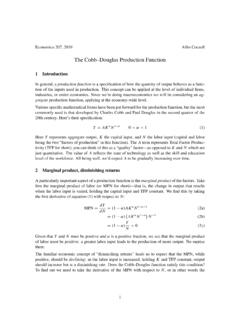Transcription of The Labour Share in G20 Economies - OECD
1 1 The Labour Share in G20 Economies International Labour Organization Organisation for Economic Co-operation and Development with contributions from International Monetary Fund and World Bank Group Report prepared for the G20 Employment Working Group Antalya, Turkey, 26-27 February 2015 2 Introduction National income is the sum of all income available to the residents of a given country in a given year. The division of national income between Labour and capital is called the functional distribution of income. The Labour income Share (or Labour Share ) is the part of national income allocated to Labour compensation, while the capital Share is the part of national income going to capital. A falling Labour Share often reflects more rapid growth in Labour productivity than in average Labour compensation, and an increase in returns to capital relative to Labour . A detailed description of the Labour Share and how it is measured is presented in Annex A.
2 Labour shares have long been considered stable and therefore attracted little attention from research and policy discussions. Yet, in recent years, a growing body of evidence suggests that Labour shares have seen a secular downward trend with important negative consequences. For instance, with declining Labour shares, improvements in macroeconomic performance may not translate into commensurate improvements in personal incomes of households (Atkinson 2009). And data shows that over time and across many countries, a higher capital Share is associated with higher inequality in the personal distribution of income (Piketty 2013). A declining Labour Share can also have political consequences if it erodes support for market-oriented economic policies or for globalization more broadly. Importantly, trends in Labour shares negatively affect the main macroeconomic aggregates, namely household consumption, private sector investment, net exports and government consumption (ILO 2012; Wolf 2014).
3 This paper reviews recent trends in the Labour Share in G20 countries (and over a long period of time in a few) and discusses possible causes of the observed trends. It then explores linkages between the Labour income Share and the main components of aggregate demand. Other critical issues such as the growth and employment impacts of the Labour Share and policy implications are raised in the paper Strengthening the link between employment and growth submitted to the EWG meeting of 26-28 February 2015 and will be discussed in more detail in a follow-up paper for the third EWG meeting (23-25 July 2015). 1. Recent trends in G20 countries (a) Labour shares At least until the 1980s, a stable Labour income Share was accepted as a stylized fact of economic Over the past decades, however, this conventional wisdom has been 1 These empirical findings date back to the early twentieth century, when Arthur Bowley first observed such regularity using British data from the nineteenth and twentieth centuries and formulated Bowley s Law.
4 Paul douglas made a similar finding regarding the Labour Share in the United States, and developed, together with the mathematician Charles cobb , the famous cobb douglas production function, which simplifies economic modelling by assuming that the functional income distribution between Labour and capital always remains constant (see Mankiw, 2003). Keynes described this empirical constancy as a bit of 3 challenged by the empirical evidence, which indicates a downward trend for the Labour Share in many of the countries for which data are available. The OECD (2012) has observed, for example, that over the period from 1990 to 2009 the Share of Labour compensation in national income declined in 26 out of 30 advanced countries for which data were available, and calculated that the median (adjusted) Labour Share of national income across these countries fell from per cent to per cent. A more recent OECD calculation finds that the average adjusted Labour Share in G20 countries went down by about percentage points per year between 1980 and the late Similar downward trends have been observed by other international institutions (IMF, 2007; European Commission, 2007; BIS, 2006; ILO, 2012).
5 In the case of emerging and developing Economies , the evidence appears to be more mixed and somewhat ambiguous. Nonetheless, the ILO finds that in many emerging and developing countries the decline in the Labour income Share is even more pronounced than in advanced Economies , with considerable declines in Asia and North Africa and more stable but still declining wage shares in Latin America (ILO-IILS, 2011). Two recent global reviews of Labour income shares also documented significant declines in some of the large Labour -abundant emerging countries (Karabarbounis, 2013), while also pointing out the greater fluctuations and oscillations in developing countries (Guerriero, 2012). A number of institutions produced data on Labour Share estimates. The annual macro-economic database (AMECO) of the European Commission's Directorate General for Economic and Financial Affairs) provides data based on National Accounts on the adjusted Labour shares for 11 of the G20 countries plus Spain.
6 The Labour income Share is calculated as the compensation of employees over total economy GDP multiplied by total employment. From the two published series market prices and factor costs3 the long-term downward trend in Labour income shares is evident, as can be seen in Figure 1. When GDP is measured at market prices, the average Labour Share for the 9 countries with data from the 1960s declines from a peak of more than 65 per cent to about 56 per cent in the most recent year (Figure 1, pane A). When measured at factor cost, the Labour Share declines from an average of 72 per cent to 63 per cent (Figure 1, panel B). a miracle (Keynes, 1939) and later Solow questioned the reliability of the empirical evidence (Solow, 1958) (see La Marca and Lee, 2013). 2 This estimation uses current basic prices.
7 If factor costs are used, the results are similar (see Annex A on measurement issues). The Labour Share is defined here as the Share of net national income that is received by workers in the form of Labour compensation. 3 AMECO calculates this adjusted Labour Share with GDP at market prices as well as with GDP at current factor cost ( minus taxes and plus subsidies). According to Guerriero (2012) the latter is more meaningful, since taxes do not represent any kind of return to capital or land. 4 Figure 1. The adjusted Labour income Share in selected G20 countries and Spain, estimated by AMECO Panel A. Market prices Panel B. Factor cost Note: The 9 countries are Australia, Canada, Germany, France, Italy, Japan, Spain, the United Kingdom and the United States. The other series include respectively the Republic of Korea (10 countries), Mexico (11 countries) and Turkey (12 countries). Source: AMECO. The downward trend since the 1990s is also observed by ILO, whose estimates of the adjusted and unadjusted Labour shares are based on main national accounts from UN Data (Figure 2).
8 The unadjusted Labour Share is calculated as total compensation over GDP, and the adjusted Labour Share increases the unadjusted Labour Share by the ratio of self-employed (for a sample of countries for which both series can be constructed between 1992 and 2011). The period covered is shorter than in the AMECO database, but includes a larger sample of G20 countries. The adjusted Labour shares declines from an average of about 58 per cent to about 55 per cent, and the unadjusted Labour Share falls from 51 per cent to 49 per cent. Both Figures 1 and 2 show that during the depths of the global economic crisis the longer term downward trends paused or slightly reversed but began to decline again following 2009. This reflects the reality that wages tend to be less volatile than profits during economic downturns. The OECD observed: In times of economic recession, this decline [in the wage Share ] has typically paused, but then subsequently resumed with a recovery.
9 The recent economic and financial crisis and subsequent sluggish recovery have not deviated from this general pattern (OECD, 2012b, p. 112). Indeed, in most countries, the Labour Share tends to increase in the initial years of recessions and then resume its negative trend afterwards. This countercyclical behaviour of Labour shares in advanced Economies has been well documented (see for example the box in IMF, 2012). 4550556065707519601963196619691972197519 7819811984198719901993199619992002200520 082011average 12 countriesaverage 11 countriesaverage 10 countriesaverage 9 countries5 Figure 2. The adjusted and unadjusted Labour shares in selected G20 countries, estimated by ILO Note: To estimate adjusted Labour income shares the projections of number of self-employed from the ILO Global Employment Trends (GET April 2014 (LP)) are used. Data for the selected group of countries includes EU-28, Australia, Canada, France, Germany, Italy, Japan, The Rep.
10 Of Korea, the Russian Federation, South Africa, United Kingdom and the United States. Source: ILO based on main National Accounts from UN DATA ( ). Data using a diversity of sources are used to highlight changes in the Labour Share at the country level revealing a decline in the vast majority of countries (Figure 3). The trends in the aggregate Labour Share need to be interpreted with some caution due to a number of measurement issues (see Annex A). For instance, the evolution of the Labour Share in the private sector4 is likely to be shaped by different forces than the corresponding aggregate for the public sector, where measurement of output and factor shares raises more complex issues. By contrast, the private represents a consistent aggregate and measurement issues regarding the Labour Share are less problematic, at least in OECD 4 Refers to those industries where most firms are privately-owned (also referred to as business-sector ).

















